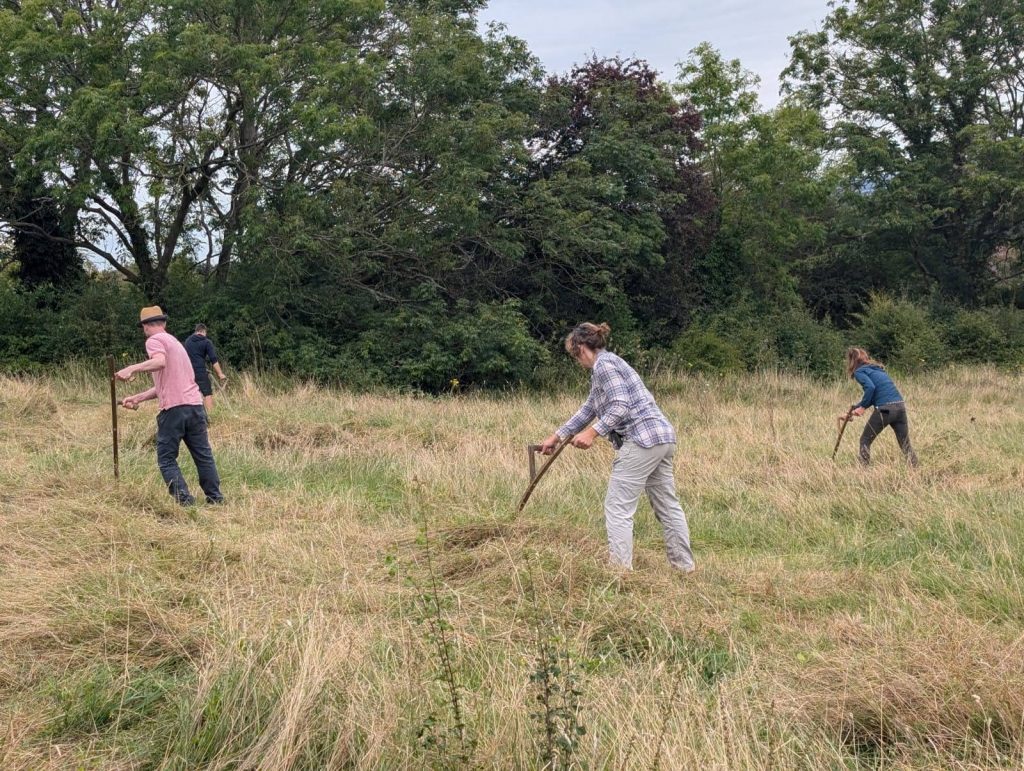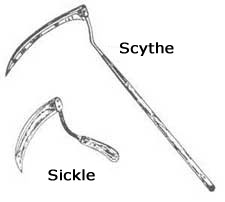Who would choose to mow a meadow by hand when there are tractors and machinery that can do it in minutes?
Me, as it turns out.

Scythes have been used as far back as 5,000 BC – according to Wikipedia. They are agricultural hand tools for mowing grass and crops. And they are not sickles – which is definitely what I thought before I learnt to scythe with Andi Rickard of Somerset Scythe School.
(A sickle has a short handle and semi-circular blade that is used with one hand. They are much smaller than scythes, which has a much larger handle – or snath/snaith with 2 grips attached – to use the correct terminology – and larger blade).

Adapted from a public-domain illustration created by the Federal Highway Administration, Public Domain, https://commons.wikimedia.org/w/index.php?curid=12428
There’s a lot to scything – new words (peening*, anyone?), putting your scythe together, scything technique, and maintenance and repair. And it seemed at first that the chances of becoming an efficient and effective scyther were slim to none. My rampant motion sickness from moving my head from side to side, weak forearms and arthritis-prone hands did not seem to combine with with the technical intricacies of scything. But it turns out there are modifications to overcome many physical ailments, and, like with most things, a bit of practice, concentration and determination goes a long way.
There are many benefits to scything over machine mowing. As the Somerset Scythe School website says it “requires no fossil fuels, leaves no pollutants, makes (almost) no noise, it keeps you fit and it’s great fun!” From a conservation perspective, it supports and maintains biodiversity as it’s much more gentle on the land than machinery: it avoids soil compaction, which fosters natural plant reproduction. And it lends itself perfectly to mosaic mowing, where the land is mowed at different times or in different ways, which helps create a mosaic of vegetation types, allowing for greater biodiversity.
At Stoke Park it will be used in some fields as part of a larger management plan that encourages biodiversity across the park – the fields that are mown with scythes will differ from those grazed by cows, or those cut for hay by machinery. All of this comes together, along with other maintenance and conservation activities to create a mosaic of grassland, wetland and woodland habitats that support myriad wildlife as well as providing a brilliant space for the communities of people who live around the Park.
In addition keeping these traditional skills alive means there is a range of options available for land management, reducing reliance on fossil fuels, and reducing the costs to manage the land. From a personal perspective, it’s great to have the chance to learn new skills.
By the end of the session, I was experiencing a consistent, satisfying swish as my scythe sliced through the long grass, had a relatively even row of mown grass behind me, and was beginning to feel at one with the scythe and the land.
*Peening is the process of working a metal’s surface to improve its material properties. In the case of scything, it’s used to shape the blade and keep it strong as it gets worn down by use, with a good sharp profile.